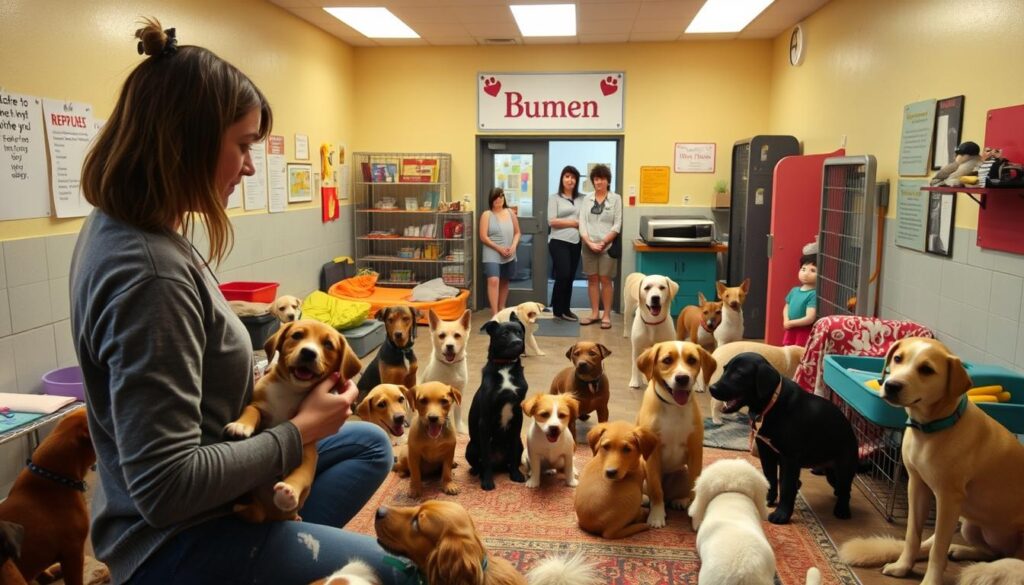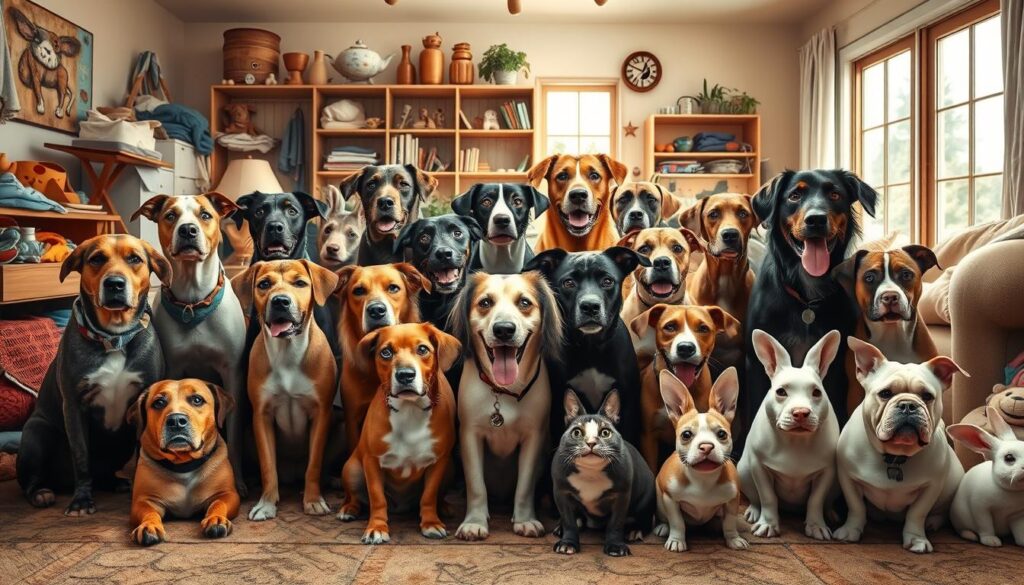Adopt, Don’t Shop: Why Rescuing is the Best Choice

Imagine walking into a shelter and hearing a soft bark or a gentle meow. That moment when you meet an animal waiting for a home is special. It’s the heart of adopt don’t shop.
Every year, millions of pets in the U.S. face uncertainty in overcrowded shelters. Your choice to adopt isn’t just about saving one life. It’s a ripple that changes communities and hearts.
Buying from a breeder or store means turning away a pet in need. Shelters have purebreds, puppies, and kittens, just like those sold elsewhere. By choosing pet adoption, you’re breaking cycles of overpopulation.
You’re giving hope to animals who’ve faced abandonment. It’s a decision that saves twice. One life walks out your door, and space opens for another to be saved.
This isn’t just about ethics—it’s about love. Every adoption creates a story where compassion meets action. Ready to start yours?
Understanding the “Adopt, Don’t Shop” Movement
This movement started as a call for ethical pet ownership. It began in the 1980s when people exposed puppy mills and showed the problem of overcrowded animal shelters. It has grown into a big change in our culture.
The Origins of the Movement
In the 1980s, animal welfare groups came together to fight puppy mills and high euthanasia rates. They encouraged people to visit animal shelters. Local events like adoption fairs helped pets find homes, reducing neglect and overpopulation.
Why It Continues to Gain Momentum
- Social media shares stories of pets finding homes
- Influencers talk about their rescue pets
- Online databases like PetFinder make finding pets easy
How It’s Changing Animal Welfare
More animal shelters now offer low-cost spay/neuter programs. Laws like California’s 2010 shelter reform act make adoptions a priority. Today, 67% of Americans prefer adopting from shelters, according to 2023 ASPCA data.
Adopting a pet is more than a personal choice—it’s part of a movement saving lives. Your choice supports shelters and helps create a better future for animals in need.
The Heartbreaking Reality of Pet Overpopulation
Every year, millions of shelter animals face an uncertain future in overcrowded shelters. In the U.S., about 6.5 million cats and dogs enter shelters each year. Sadly, around 1.5 million are euthanized because of lack of space or resources. This doesn’t count smaller animals like rabbits or birds, who also struggle.
Overpopulation is a cycle. Pets that aren’t spayed or neutered can have many babies. This leads to more animals in shelters. Events like spring’s “kitten explosion” or post-holiday puppy abandonments make things worse. Commercial breeders make money while rescue pets wait for homes.
- 70% of shelter dogs and 75% of cats are euthanized in some regions
- Unaltered pets produce 67,000 puppies/kittens in 6 years
- Adoption rates have risen 15% in the last decade, but demand for purebreds is high
Shelter workers make tough choices every day. They decide which animals stay, go to foster care, or are humanely euthanized. But this isn’t just a sad story—it’s a call to action. By adopting, you create space, fund life-saving programs, and help break the breeding cycle. Every rescue pet you choose weakens the cycle of overpopulation. Your decision today can change the future for countless animals tomorrow.
Life-Saving Benefits: How Your Adoption Saves Multiple Lives
Adopting a pet saves a life and has a ripple effect. It helps animals far beyond your new friend. Your choice makes a big difference.
Direct Impact on the Pet You Adopt
Your choice to adopt gives a second chance to a vulnerable animal. Shelter animals often face overcrowding or euthanasia. But in a loving home, they flourish:
- 85% of adopted pets show improved behavior within months of adoption
- Medical care and stability boost longevity
- They gain lifelong companionship
Creating Space for Other Animals in Need
Every adoption makes room for more animals. Shelters can:
- Rescue more strays during crises
- Reduce euthanasia rates
- Rehome animals that might be overlooked
Breaking the Cycle of Breeding
Adopting instead of buying stops unethical practices. When demand drops, puppy mills lose money. This change:
- Reduces demand for mass-produced pets
- Protects animals from inhumane breeding conditions
- Strengthens the movement to end commercial breeding
Finding Your Perfect Match: Navigating Animal Shelters and Rescue Organizations
Choosing the right pet means knowing where to look. You can search in person or online for your perfect match.

Local vs. Specialized Rescues
Local animal shelters have a wide range of pets. Specialized rescues focus on certain needs, like senior pets or purebreds. Visit both to see which fits your lifestyle.
Online Resources for Finding Adoptable Pets
Online searching can make your search easier. Try these sites:
- Petfinder: Filter by breed, age, and location.
- Adopt-a-Pet: Features profiles and adoption event calendars.
- Your local animal shelter’s website for real-time listings.
Questions to Ask Before Adopting
Be ready with these questions for your visit:
- What’s the pet’s health history?
- Have they been socialized with other pets?
- What adoption requirements do you have?
- What support do you offer after adopting?
Take your time. Choosing a pet is a big decision. Ask all your questions to make the best choice.
Adopt, Don’t Shop: Why Rescuing is the Best Choice for Your Family
Bringing a pet into your home is a joyful step for any family. Choosing to adopt don’t shop turns this moment into a lesson in empathy and love. Shelter pets often crave the stability of a family, making them eager to bond with everyone—from toddlers to grandparents. This decision becomes a shared adventure that strengthens family connections.
- Teach Responsibility: Let kids help pick a pet’s bed or toys to build ownership and care.
- Pre-Screened Companions: Shelters match pets to your family’s energy and lifestyle, ensuring a smooth transition.
- Shared Joy: Watching a rescued pet thrive creates stories that bond your family for years.
Wondering if a shelter pet suits your home? Many are already socialized and ready to join active households. Shelters assess behaviors, so you can trust their recommendations. Plus, involving children in the process teaches them compassion firsthand—making adoption a family value they’ll carry forward.
Adopt don’t shop means more than adding a pet; it’s a chance to grow together. Families who adopt often find pets that adapt quickly to routines, easing the transition. Imagine bedtime stories about giving a second chance or weekend walks where every family member feels responsible for their new companion. This is how rescuing becomes the best choice for creating lasting memories.
Debunking Common Myths About Shelter Animals
Many myths about shelter animals keep people from adopting. The truth is, rescue pets are eager to find loving homes. Let’s clear up these misconceptions.

The “Damaged Goods” Misconception
Some think shelter animals are broken. But, most are here because of their owners’ life changes, not their fault. Reasons include:
- Owners moving
- Financial struggles
- Allergies in families
Actually, over 90% of shelter animals are here for no fault of their own. Shelters match pets with adopters based on personality, not past.
Purebreds in Shelters: More Common Than You Think
Did you know purebreds make up 25-30% of shelter animals? It’s due to overbreeding and owner surrender. You can find your desired breed through groups like:
- American Bulldog Rescue
- Golden Retriever Foundation
Breed-specific rescues help you find purebreds without supporting puppy mills.
Behavioral and Health Concerns Addressed
Shelters thoroughly check each rescue pet’s health and behavior. Vets look for medical issues, and staff observe behavior. They share all findings upfront. Unlike some breeders, shelters are open about what pets need. The ASPCA says shelters provide:
- Medical reports
- Behavior assessments
- Advice for new owners
Adopters get honest information to make informed choices. Experts like Dr. Jane Smith (vet) say shelters focus on transparency to ensure long-term matches.
The Adoption Process: What to Expect When You’re Expecting a Pet
Adopting a pet is a thoughtful process to ensure a happy match. First, fill out an online application. Share details about your lifestyle and family. Shelters then review applications to find pets that fit your home.
- Application Screening: Submit forms about your schedule, living space, and pet care experience. Shelters may ask about past pets or family members.
- Home Visit: A staff member might visit your home to check safety. This ensures your space is secure for the pet’s well-being.
- Meet-and-Greet: Spend time with the pets to see how they interact with you and your family. This step helps avoid mismatches.
- Final Steps: Sign contracts, pay fees, and collect your pet’s medical records. Some shelters offer post-adoption support.
Prepare documents like ID, rent agreements, or vet references to speed up the process. Be honest about your time availability and home setup—this builds trust with staff. While waiting, stay patient; their checks aim to prevent returns and ensure lifelong bonds.
- Bring copies of IDs, rental agreements, and emergency contacts.
- Ask questions about the pet’s history and needs.
- Follow staff guidance to show you’re a responsible adopter.
Every step exists to protect both you and the animal. If a pet isn’t a fit, shelters will suggest alternatives. Remember, adopt a pet that aligns with your daily life for lasting happiness. Celebrate the process as part of building your forever bond!
Financial Considerations: Why Adoption is Often More Affordable
Choosing to adopt a pet saves lives and money. Let’s look at how adoption compares to buying from breeders or stores.
Comparing Adoption Fees vs. Breeder Costs
Adoption fees are lower, ranging from $50 to $500. Purebred pets from breeders start at $1,000+. Here’s a comparison:
- Adoption: Includes basics like vaccinations and spaying/neutering
- Breeders: May charge extra for paperwork or breeding certifications
Hidden Value in Medical Care
Adoption fees often include services that cost hundreds separately:
- Spay/neuter procedures ($100–$300)
- Vaccinations ($50–$200 per shot)
- Microchipping ($45–$80)
This is up to $1,000+ in savings in your adoption fee.
Long-Term Savings of Adopted Pets
Mixed-breed rescues often have fewer health issues than purebreds. This means lower vet bills over time. Purebreds from commercial breeders face higher risks of conditions like hip dysplasia or heart disease, costing owners thousands in care. Adopted pets also come pre-screened for behavior, reducing training expenses.
Adoption is not just the best choice for animals—it’s also smart for your wallet. Every dollar saved lets you focus on loving your new companion, not worrying about money.
Preparing Your Home for Your Rescue Pet
Bringing home a new pet is exciting. Preparing your space helps both you and your new friend adjust smoothly. Start by gathering supplies and making your home welcoming.
Essential Supplies for Day One
Every rescue pet needs basic items. Dogs need a durable leash, food, and a crate. Cats need a litter box, scratching post, and good kibble. Small animals like rabbits or guinea pigs need hay, a safe cage, and chew toys.
Always choose items that fit your pet’s size and breed.
Creating Safe Spaces for Adjustment
- Make a quiet room with familiar smells, like a shelter towel, to help your pet feel safe.
- Pet-proof rooms by securing electrical cords, hiding toxic plants, and blocking small spaces.
- If you have other pets, introduce them slowly using baby gates or separate feeding areas.
Setting Realistic Expectations
Adjustment times vary. Most pets take 1–4 weeks to settle. Expect shyness or accidents at first. Be patient—it’s normal.
Consistent routines and positive reinforcement help them adjust faster.
Adopting a pet is a lifelong commitment. Thoughtful preparation gives your new friend the best start. Your efforts will strengthen your bond and ensure a happy, healthy transition.
Supporting Animal Shelters Beyond Adoption
Animal shelters need our help every day. They care for many animals. Even if you can’t adopt, there are many ways to help.
- Give financially: Regular donations help cover food, medical care, and shelter operations. Many shelters accept one-time or monthly gifts.
- Volunteer your time: Walk dogs, clean kennels, or assist with social media. Shelters need help with both animal care and office tasks.
- Foster a pet: Open your home temporarily to prepare shelter animals for adoption. This reduces stress and eases overcrowding.
- Host a fundraiser: Organize a bake sale or charity walk. Every dollar raised makes a difference.
- Donate supplies: Drop off blankets, toys, or food. Check with your local shelter for specific needs.
- Spread the word: Share adoption stories online. Educate friends about the benefits of adopting instead of buying. Contact local officials to support animal welfare laws.
Your advocacy strengthens the network that protects shelter animals. Whether you donate an hour or a dollar, your actions create lasting change. Visit local shelters to see how your skills can help—every contribution matters.
Your New Best Friend is Waiting: Taking the First Step Today
Every day, animals in shelters across the U.S. need someone to give them a second chance. Adopting a pet is more than finding a new friend—it’s saving a life. It’s also welcoming a loyal companion into your home. Ready to start your journey? Think about what you want in a pet: energy levels, space needs, or age.
Shelters like the ASPCA or local rescues have profiles online to explore. They help you find the perfect match.
Next, visit nearby shelters or use platforms like PetFinder to meet pets. Staff can help you find the right animal for your lifestyle. Applications are quick and easy, and often include vaccinations or spay/neuter services.
Shelters also offer resources for adjusting to pet care, no matter your experience. Every adoption helps break the cycle of overpopulation. It frees up space for another animal in need.
Don’t wait for “the perfect time.” Your perfect pet is waiting. Browse websites, call a local shelter, or visit to say hello. The first step is hard, but the reward is a lifelong bond. Open your heart and home today—the life you save could become your greatest adventure.



